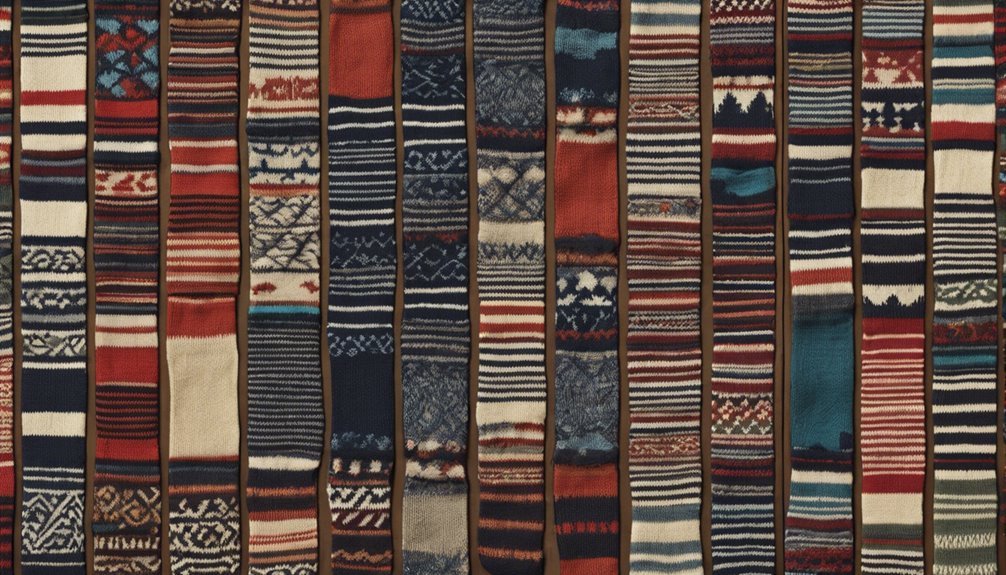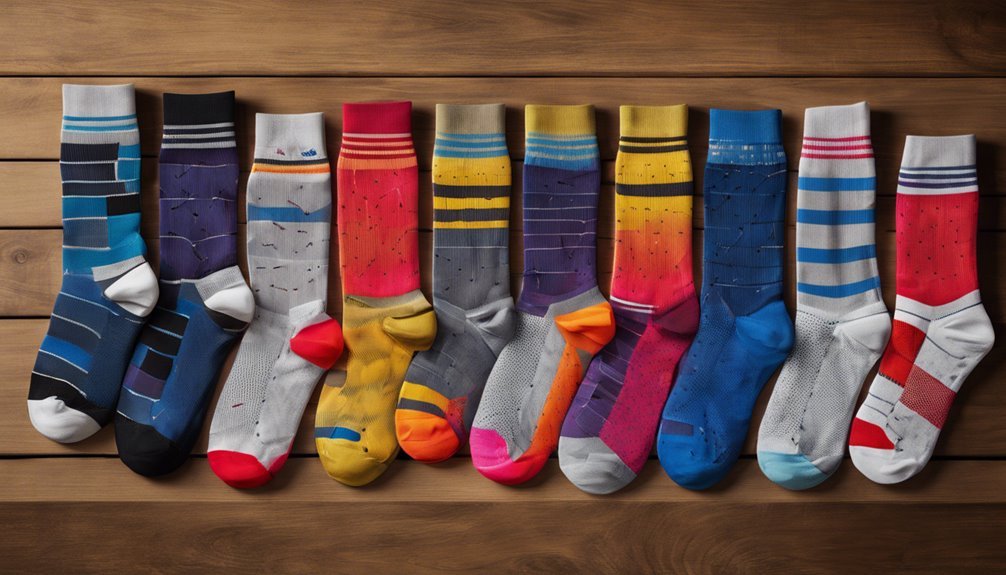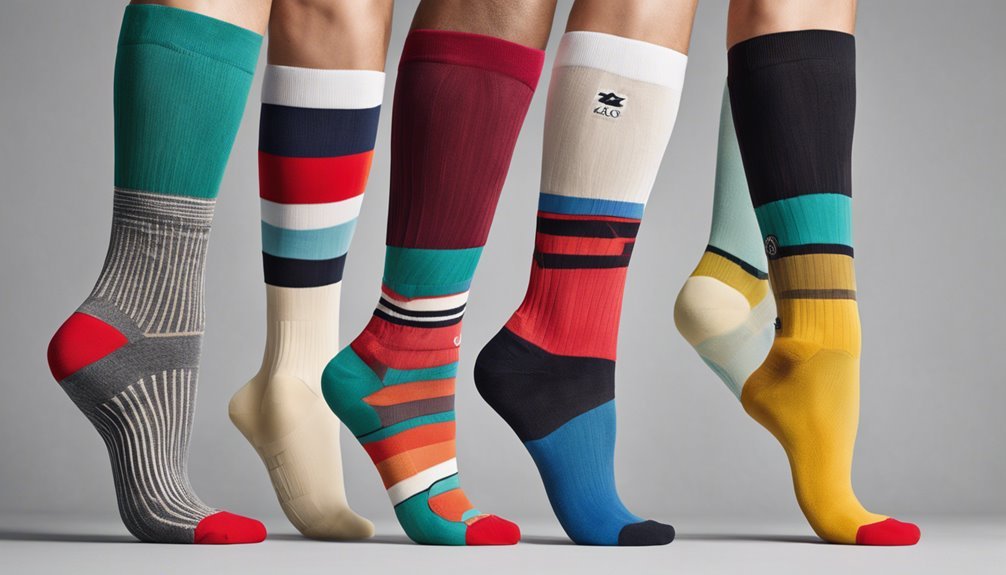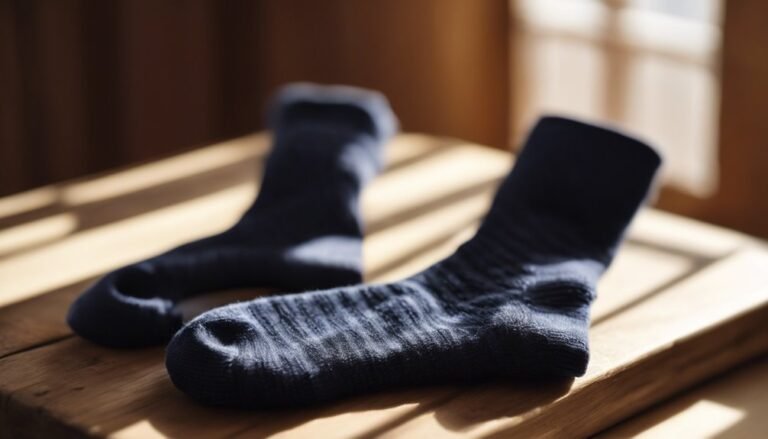The Evolution of Sports Socks: How Athletes’ Gear Has Changed
Imagine this: you're watching an intense tennis match, and the camera zooms in on the players' feet. You notice their socks—a far cry from the simple foot coverings worn by athletes in ancient civilizations.
Today, sports socks are high-tech athletic gear, complete with moisture-wicking fabrics and compression technology, enhancing both performance and comfort.
But have you ever wondered how these humble foot coverings evolved into such sophisticated pieces of athletic equipment? As design influences offer customization in aesthetics and support, sports socks are now tailored to meet diverse needs.
With rising environmental consciousness, sustainable practices in production are gaining importance, making these advancements an essential part of the athletic experience.
Explore how these changes have transformed sports socks from basic necessities to crucial components in sports.
The Origins of Sports Socks: From Ancient Times to Modern Beginnings

Although often overlooked in the grand tapestry of sports history, the evolution of sports socks traces back to ancient civilizations where functionality and status were woven into their very fabric. You might find it fascinating that the ancient Egyptians used linen, a symbol of purity, to create the earliest forms of socks. These ancient textiles served both practical and symbolic purposes, offering protection and denoting social standing. Fast forward to the Roman era, where socks became integral to athletic footwear, providing added comfort and support during physical activities. By understanding these origins, you can appreciate the freedom and choices available today in sports gear. The journey from simple cloth wrappings to modern designs reflects a deep connection between culture, utility, and personal expression.
The Role of Material Innovation in Enhancing Performance
When you consider the evolution of sports socks, material innovation stands out as a vital factor in enhancing athletic performance. Lightweight fabrics have revolutionized comfort by reducing bulk and allowing for greater freedom of movement, making them indispensable for athletes. Additionally, moisture-wicking technology plays a critical role by efficiently managing sweat, keeping you dry and focused, ultimately boosting your overall performance.
Lightweight Fabrics Revolutionize Comfort
As advancements in textile technology continue to surge, lightweight fabrics have become a cornerstone in the quest for superior comfort and performance in sports socks. You'll find that breathable materials not only enhance comfort but also boost performance by allowing your feet to stay cool and dry. This innovation liberates athletes, letting them focus on their game without distraction.
| Feature | Benefit |
|---|---|
| Lightweight Fabric | Reduces fatigue |
| Breathable Materials | Keeps feet cool |
| Enhanced Flexibility | Improves agility |
| Durable Composition | Extends lifespan |
| Eco-Friendly Options | Promotes sustainability |
These fabrics are meticulously engineered to balance softness and durability, granting you the freedom to push your boundaries. They're not just about comfort; they're about performance enhancement, empowering you to perform at your peak.
Moisture-Wicking Technology Boosts Performance
While sports socks have evolved considerably over the years, perhaps the most transformative advancement is the integration of moisture-wicking technology. This innovation is more than just a trend; it's a game-changer in moisture management. Imagine you're on the field, pushing your limits, and your socks actively work to keep you comfortable by drawing sweat away from your skin. The advanced fibers facilitate sweat evaporation, ensuring your feet stay dry and blister-free. This kind of freedom is essential, allowing you to focus on your performance without distraction. The strategic blend of synthetic and natural materials optimizes airflow and enhances breathability. So, whether you're sprinting or hiking, moisture-wicking socks empower you to perform at your peak, unburdened by discomfort.
Moisture-Wicking Fabrics: Keeping Athletes Dry and Comfortable

In the quest to enhance athletic performance, moisture-wicking fabrics have emerged as a game-changer, revolutionizing how athletes experience comfort during intense physical activities. These fabrics integrate breathable membranes that efficiently channel sweat away from your skin. This design guarantees effective sweat management, vital for maintaining ideal body temperature and preventing chafing.
When you're free to push your limits without worrying about discomfort, these innovative materials offer an edge. They allow you to focus solely on your performance rather than being distracted by the dampness of traditional fabrics. Embracing this technology means embracing the freedom to perform under any condition. Moisture-wicking fabrics aren't just about staying dry; they're about releasing your potential by keeping you comfortable, no matter how intense the game gets.
The Rise of Compression Technology in Sports Socks
Beyond moisture-wicking fabrics, another technological advancement reshaping athletes' experiences is compression technology in sports socks. You might wonder why compression is such a game-changer. These socks apply gentle pressure to your legs, enhancing blood circulation and oxygen delivery to muscles. This means fewer cramps and faster recovery times—key compression benefits that can't be ignored. For athletes seeking freedom in their performance, this technology offers a tangible edge. Imagine reducing lactic acid buildup and minimizing soreness, allowing you to push boundaries without hesitation. Athlete recovery isn't just about resting; it's about actively managing your body's response to exertion. Compression socks have become essential in this process, empowering you to train smarter and recover efficiently, paving the way for peak performance.
Cushioning and Support: Reducing Impact and Preventing Injuries

As athletes push their limits, the importance of cushioning and support in sports socks becomes increasingly evident. Modern sports socks are engineered to provide impact reduction, essential for minimizing the strain on your feet and joints during intense activities. This sophisticated design cushions each step, reducing the risk of injuries like stress fractures and plantar fasciitis.
You'll appreciate how advanced materials and strategic padding work together to offer targeted support where it's needed most. This isn't just about comfort—it's about injury prevention that keeps you active and free to pursue your passions without hindrance. The evolution in sock technology guarantees that every leap, sprint, or pivot is met with resilience, allowing you to remain on the move with confidence and agility.
The Influence of Design on Functionality and Style
While cushioning and support play pivotal roles in safeguarding athletes, the design of sports socks profoundly impacts both their functionality and style. You'll notice that the aesthetic appeal isn't just about looking good; it's about how design can enhance performance. Ergonomic design factors guarantee that socks fit seamlessly with an athlete's movements, reducing friction and optimizing comfort.
| Aspect | Impact on Socks |
|---|---|
| Aesthetic Appeal | Boosts confidence and team identity |
| Ergonomic Design | Enhances fit and reduces blisters |
Customization and Personalization: Tailoring Socks for Individual Needs
In today's sportswear landscape, you've got the power to tailor your socks to meet specific needs through advanced material selection, allowing for ideal comfort and durability. With unique design preferences, you can express individuality while guaranteeing that the socks complement your athletic style. Enhanced performance features, such as targeted cushioning and moisture-wicking capabilities, assure that the socks are not just an accessory but a critical component of your sports gear.
Advanced Material Selection
Although the landscape of sports apparel has seen numerous innovations, few aspects have evolved as significantly as the materials used in sports socks, especially when it comes to customization and personalization. Imagine a sock that not only fits your foot perfectly but is crafted from smart textiles that adapt to your movements. These advanced materials can monitor moisture levels, ensuring ideal comfort and performance. Plus, they're becoming increasingly eco-friendly, reducing your carbon footprint while enhancing athletic prowess. By selecting materials that cater to your specific needs, you're not just buying a sock; you're investing in a tailored experience. This freedom of choice empowers you to demand better performance, comfort, and sustainability—all wrapped up in a seemingly simple piece of sports gear.
Unique Design Preferences
With the rise of consumer-driven customization, sports socks have become a canvas for expressing individual preferences and needs. You're not just choosing a sock; you're crafting a statement. Color preferences and pattern trends let you tailor your gear to match your personality or team spirit. The freedom to choose vibrant hues or subtle shades reflects your unique tastes, while patterns like stripes or polka dots add a layer of personal flair.
| Feature | Options |
|---|---|
| Color Preferences | Vibrant, Subtle, Monochrome |
| Pattern Trends | Stripes, Polka Dots, Abstract |
| Material Choices | Cotton, Synthetic, Wool |
| Length | Ankle, Crew, Knee-high |
Understanding these options helps you create a distinctive identity on the field, making your sports socks more than just functional—they're an extension of you.
Enhanced Performance Features
As you explore the domain of enhanced performance features in sports socks, it quickly becomes evident that customization and personalization are essential in meeting the diverse needs of athletes. You see, every athlete's foot is unique, requiring gear tailored to optimize performance and comfort. By incorporating breathable mesh, socks now deliver superior ventilation, keeping your feet cool and dry during intense sessions. This feature is particularly significant in preventing blisters and discomfort, allowing freedom of movement without constraint. Additionally, personalized arch support guarantees that your foot's natural contour is respected, minimizing fatigue and enhancing endurance. With these innovations, you're not just wearing a sock; you're adopting a tool that aligns with your personal athletic journey, offering both freedom and performance.
The Environmental Impact: Sustainable Materials and Practices
Even as the demand for sports socks continues to grow, it's crucial to contemplate the environmental implications of their production. Sustainable production is key to reducing the ecological footprint of sportswear. You can embrace eco-friendly materials like organic cotton, recycled polyester, or bamboo, which greatly cut down on resource consumption.
Consider these aspects when evaluating sustainable practices:
- Water Usage: How much water is saved by using recycled materials?
- Energy Consumption: Are renewable energy sources part of the production process?
- Waste Reduction: What measures are in place to minimize waste?
- Chemical Impact: Are harmful chemicals avoided in dyeing processes?
- Durability: Do these materials guarantee longevity, reducing the need for frequent replacements?
Future Trends in Sports Sock Technology and Design
While the sports sock industry has traditionally focused on performance and comfort, future trends are set to revolutionize both technology and design, offering a glimpse into a more advanced era of sportswear. Imagine socks embedded with smart textiles that adapt to your body's needs. These innovations could monitor temperature, moisture, and even fatigue levels, giving athletes unparalleled insights and control. Biomechanical enhancements might include supportive structures that align with your foot's natural movement, enhancing performance while reducing injury risks. As you embrace these technological marvels, you'll find a blend of freedom and functionality, opening new possibilities. The future of sports socks isn't just about wearing gear; it's about integrating technology that optimizes every step you take.
Frequently Asked Questions
How Often Should Sports Socks Be Replaced for Optimal Performance?
You shouldn't underestimate sock lifespan. Replace them every 3-6 months for ideal performance. This replacement frequency balances durability and comfort, ensuring freedom on the field. Always assess wear and tear to maintain your athletic edge.
Can Sports Socks Affect an Athlete's Overall Performance in Competition?
When you hit the ground running, sports socks can greatly impact performance. Advances in sock technology minimize friction, manage moisture, and enhance support, letting you focus on freedom of movement without worrying about your gear holding you back.
What Are the Most Common Myths About Sports Socks?
You might think sock thickness always guarantees comfort or that moisture-wicking is unnecessary, but these myths limit your choices. Embrace freedom by understanding how the right balance enhances performance, keeping you dry and comfortable during competitions.
How Do Sports Socks Differ Between Various Sports Disciplines?
You'll find sports socks differ greatly; basketball socks often emphasize compression technology for support, while running socks focus on moisture control. Each discipline tailors socks to enhance performance and comfort, offering athletes the freedom to excel.
Are There Specific Washing Instructions for Maintaining Sports Socks' Quality?
Imagine your socks as warriors needing care after battle. To maintain their integrity, use gentle washing techniques and respect sock materials. Delicate cycles and mild detergents keep them ready for the freedom of your next adventure.







